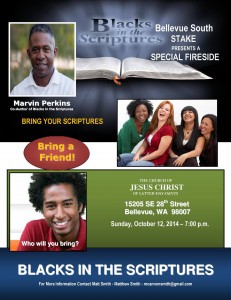Waking Up
I vividly remember an experience with my youngest daughter who was around four-years-old at the time. I was using public transportation to get to and from campus where Sara attended preschool while I attended classes. A younger mother on the bus held her baby. The baby’s complexion was dramatically darker than his mom’s. She nuzzled her child, talked baby talk, and saturated that baby with maternal love. Sara looked at the scene then back at me several times with a quizzical expression on her face. She wrinkled her brow and looked at me again. I said, “Are you wondering about the baby’s skin color?” She said, “Yeah.” I said, “Well, the mommy is white and the baby is black. The baby’s dad is probably black.” Sara’s expression changed only slightly before she shifted the conversation in an unexpected direction and slammed my white, Utah Mormon brain up against a wall of generational prejudice. She said, “No! The mom’s skin is pink and the baby’s skin is brown.”
My daughter saw only skin tones. She had no reference for the social implications of a Caucasian mom and African American dad. She was utterly without prejudice. This awareness altered me permanently. In a single moment I was fully awakened to the crippling ideals of racial prejudice with which I’d been unconsciously indoctrinated as a child. It took my breath away. From there, my unlearning and re-learning went something like this:
- I began praying that God would reveal my inherited weakness in this area, and subsequently was granted numerous opportunities to examine my heart and mind with regard to racism. It hurt like hell. I felt betrayed at times, saddled with a burden for which I wasn’t responsible, yet must bear, and which I must ultimately find a way to lay down at Jesus’ feet.
- My college coursework included an advanced ethics and values class. We read Ishmael: An Adventure In Mind and Spirit, by Daniel Quinn. This book had a profound effect on me, partly because my heart was open and I was willing to see the truth about others and myself.
- God sent a visitor to me in a dream – a wise African man. (I had asked for a woman, but this guy said he was the right person for the job, so I believed him) He talked with me about where he came from and how the world was for him.
- Various friends and neighbors came into my life and taught me by word and example what Zion looks like. Spoiler alert: It ain’t white.
- My children continued to have relationships with friends from diverse cultural backgrounds. From all of these relationships I continued to unlearn things I had learned in childhood.
- I met Tamu Thomas-Smith, a Mormon woman of color. Her family moved into my all-white neighborhood and I felt instantly drawn to her. She was hilarious. She seemed naturally compassionate and loved the gospel and Jesus. She was also a straight-talker which appealed to me immensely. (I have to admit she had great clothes, which, you know, as much as we try to be careful about all that pride stuff . . . I love great clothes.) She had been raised in a different world than mine. That appealed to me too. As it turns out, we still live in different worlds in many ways, although we inhabit the same geographical community.
- I attended Margaret Blair Young’s first run of the stage play, I Am Jane, in 2008, when Tamu played the part of Jane Manning James, a black Mormon pioneer and beloved friend of Joseph and Emma Smith.
- I began to study blacks in Mormon history and started listening to Sistas In Zion radio. [By the way, the SiZ wrote a book and you can buy it here. You’ll love it. Zandra and Tamu are remarkable women.] On one broadcast, I called in to ask the guest, Russell Stevenson, author of Black Mormon: The Story of Elijah Ables, how a white guy became so passionate about the history of black Mormons. His answer, “I repented.”
- As time permitted, I studied U.S. black history and feminist history, including conflicts between black and white suffragists, and racial conflicts within the feminist movement in the U.S. (Another spoiler alert: this ain’t the first time white sistas have had to take a long hard look at themselves in relation to their sisters of color.) Here’s a link to an excellent recent article addressing this issue within Mormonism.
- On Sunday, June 9, 2013, the 35th anniversary of the restoration of priesthood to worthy black men and temple blessings to black women, I invited Tamu to visit my youth Sunday school class and talk about it. She graciously made time in her Sabbath day to come teach us. I invited the bishop and another large class to join us. They did and it was awesome.

- The following week I attended a special fireside presented by Marvin Perkins, Blacks in the Scriptures, which addressed myths and fallacies about language surrounding blacks in the scriptures. Brother Marvin reminded me of what Sara told me years before: black and white are not skin colors. We are all different shades of brown.
I could add many more small and large steps to this list, but I hope this sufficiently illustrates a portion of my personal evolution from a child to a woman who wants to choose the right.
What Next?
These are highlights of a journey that began for me over forty years ago. Each woman, regardless of cultural heritage, is on her own journey to move beyond the limitations of her upbringing, to carefully examine her heart and how the society in which she lives influences her thoughts and actions for good and ill.
Maybe, as Marvin Perkins suggests, the curse of blackness or darkened skin we read about in scripture isn’t really about skin pigment at all, but about the degree to which we allow or disallow ourselves to be enlightened by God. I believe God helps us when we engage in any effort to liberate others or ourselves from the curse of blackness that covers our minds like a veil, like a skin, obscuring essential truths inherent in the doctrine of Christ about justice for all people.
Like Cathy Stokes and others interviewed for the Salt Lake Tribune article, a brown sister looking at the MoFem movement can easily say, “That has nothing to do with me.” A long time ago many of our sisters gave up the idea that white men as a group would care about them. (Although Tamu will point out on an individual level her husband cares for her really well.) So, she reasons, this feminist fight isn’t really hers. And, in some ways, she’s right. Until very recently, we haven’t made a sustained effort to step outside our own self-interest as a largely white feminist community.
This doesn’t mean we are bad. It just means we have room to grow. We might do well to adjust our trajectory and listen to Mormons of color in the same way we keep hoping our white brethren will listen to us — about pain, exclusion, and relative lack of power within the LDS community and in the world at large. In the past we may have been innocent in failing to differentiate between equality and justice. We are no longer innocent. A mature understanding of the doctrine of Christ calls us to broaden our reach, to be engaged more personally in the cause of social justice–rooted in racial prejudice–with which many of our sisters are engaged on a daily basis.
The end result may be somewhat different than what we think we are trying to achieve, but it will also be better than anything we can imagine. We won’t see the result immediately, but our efforts to step outside ourselves and our current comfort level will offer a more solid and expansive foundation for the future of Mormon feminism. We know how to do this. We’ve done it before. We have a lot in common with people of color when we view the plight of Mormon pioneers as an allegory for the generations-long struggle of many of our sisters and brothers. We may have a long journey ahead, but we’re on our way. I’ll leave you with that idea and with the lyrics to the African American National Anthem.
“Lift Every Voice and Sing”
Lift every voice and sing
Till earth and heaven ring,
Ring with the harmonies of Liberty;
Let our rejoicing rise
High as the listening skies,
Let it resound loud as the rolling sea.
Sing a song full of the faith that the dark past has taught us,
Sing a song full of the hope that the present has brought us,
Facing the rising sun of our new day begun
Let us march on till victory is won.
Stony the road we trod,
Bitter the chastening rod,
Felt in the days when hope unborn had died;
Yet with a steady beat,
Have not our weary feet
Come to the place for which our fathers sighed?
We have come over a way that with tears has been watered,
We have come, treading our path through the blood of the slaughtered,
Out from the gloomy past,
Till now we stand at last
Where the white gleam of our bright star is cast.
God of our weary years,
God of our silent tears,
Thou who has brought us thus far on the way;
Thou who has by Thy might Led us into the light,
Keep us forever in the path, we pray.
Lest our feet stray from the places, our God, where we met Thee,
Lest, our hearts drunk with the wine of the world, we forget Thee;
Shadowed beneath Thy hand,
May we forever stand.
True to our God,
True to our native land.
::
Please share your thoughts, if you feel so inclined. We’d love to hear from you.






9 Responses
Well said, Melody, thank you for these thought-provoking posts. This really caught my attention:
“Brother Marvin reminded me of what Sara told me years before: black and white are not skin colors. We are all different shades of brown.”
I recently learned that my great-great-great grandmother, Harriet Church, was a slave in her childhood. At age 16, living in a household with a married couple and their 6 kids, she had a baby. The wife died a year later, and 7 more babies were born. We’re not sure if she officially married the husband of that household, but we do know they became Mormons and moved to Utah together in the 1870s, where they had 3 more babies for a total of 11 children. One of their sons is my great-great grandfather. Interestingly, in the 1900 census she is listed as white. Apparently she had a light complexion, but the First Presidency was still called upon to determine whether her sons could be ordained to the priesthood (they were). She and her husband were sealed in the temple in their old age.
That is really neither here nor there to the content of your post, except to reiterate how ridiculous and tragic it is that such deep fault lines have developed between groups of human beings over skin color.
I read Ishmael in college, too. Now I want to read it again. I love “Lift Every Voice and Sing” so much. I’ve sung it in diverse congregations and it made my scalp tingle and my heart burst. I feel a little that it’s not really mine to love, but Helen Keller loved “Come, Come, Ye Saints,” so maybe I can love the African American National Anthem.
I really want the Zion you mentioned, and I love that you prayed for God to reveal the weaknesses that get in the way of it. I think that’s the ticket for getting there.
Thanks for your comments, Emily. Especially the comment about fault lines over skin color. It is a tragedy of mortality. If Brother Perkins comes to your area, it will be worth your time to go hear him. The message is life-altering.
Thank you for including the lyrics to “Lift Every Voice and Sing.” I remember learning this song as a sixth-grader in the metro Atlanta area–and belting it out in our backyard–thrilled by the soaring melody and sense of triumphant hope.
There is so much wisdom in this post, Melody. I love the fact that you recounted all the ways you raised your consciousness about race issues, and I especially love that you had a vision featuring a black man.
“We might do well to adjust our trajectory and listen to Mormons of color in the same way we keep hoping our white brethren will listen to us — about pain, exclusion, and relative lack of power within the LDS community and in the world at large.”
I so agree with you. Mormon feminism definitely needs to expand its vision to take into account the concerns and issues of women of color. I feel like over the past few months we’ve started to have those conversations, and I think your post is filled with great ideas about how to interrogate our own assumptions, reach out to women of color, and work to better educate ourselves about issue of racial social justice. Thank you, Melody!
Thanks for your kind words, Caroline. I admit that I am a dork with many things, possibly including my attempts here to help address a problem within our feminist community. But I am a dork with a good heart and I’m hoping that heart will make up for my failings. I look forward to more and more online presence of diverse voices, specifically from our sisters of color. God bless us. Every one.
Thanks for sharing these posts, Melody. The same bit Caroline quoted struck me too:
“This doesn’t mean we are bad. It just means we have room to grow. We might do well to adjust our trajectory and listen to Mormons of color in the same way we keep hoping our white brethren will listen to us — about pain, exclusion, and relative lack of power within the LDS community and in the world at large.”
Nice comparison. I also like “adjust our trajectory.” It’s a good phrasing to maybe help us be less defensive. 🙂
Thanks, Ziff. Calling ourselves out isn’t easy. I’m sure some of what I’ve written could make people feel defensive, but I hope most people just feel reflective. That’s my hope anyway. I appreciate your kind words here.
I have had a crazy week and I am now just getting caught up reading what I wanted to read. Your poat is very insightful and has given me much more to think about on this topic. Thank you Melody for your beautiful thoughts.
[…] one of two […]